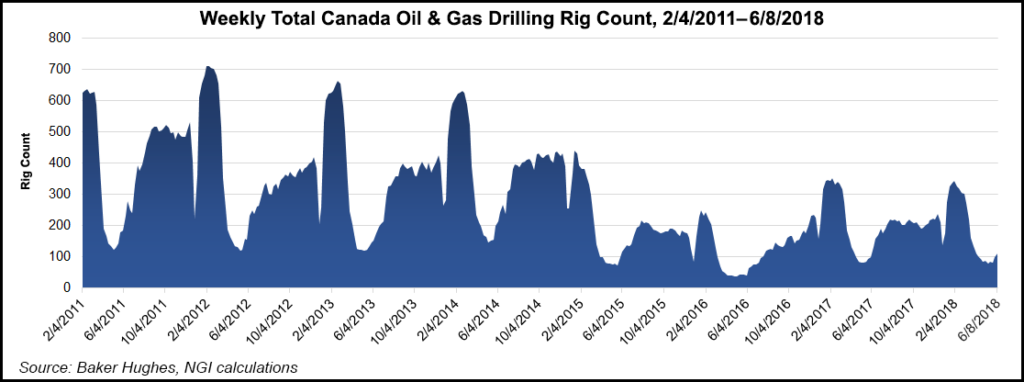E&P | NGI All News Access | NGI The Weekly Gas Market Report
Canada’s NGL Output Rising as Shale, Tight Drilling Expands
Natural gas byproducts are on the rise as a Canadian growth star, propelled by horizontal drilling and hydraulic fracturing into liquids-rich sweet spots of shale and tight gas formations in northern Alberta and British Columbia (BC).

Unconventional drilling in the Montney and Duvernay formations is forecast to generate 50% growth in natural gas liquids (NGL) production by 2026 to 500,000 b/d from today’s 326,000 b/d, predicted the Canadian Association of Petroleum Producers (CAPP).
CAPP’s newly released annual oil supply forecast, which draws on industry surveys, confirmed expectations driving about C$1 billion ($800 million) in current processing and delivery projects.
Construction is on schedule to complete Canada’s first propane overseas export terminal this fall, a 40,000 b/d operation that AltaGas Ltd. is building for C$450-500 million ($360-400 million) at Prince Rupert to fill up to 30 tankers per year.
Pembina Pipeline Corp. is collecting final regulatory approvals for a liquid petroleum gas tanker terminal, a 25,000 b/d facility also at Prince Rupert that’s scheduled to be built in 2020 for C$270 million ($216 million).
Inland, in the northern BC heart of the Montney region, Pembina and Kohlberg Kravis Roberts & Co. L.P. expect to complete an NGL processing hub before the end of this year for C$320 million ($256 million).
Exports are not the only growth force. NGLs will stay in high and rising demand as diluent, or thinner, needed for pipeline delivery of growing oilsands production, said CAPP.
“Demand for pentanes and condensate from oilsands for blending with bitumen exceeds domestic production and will remain strong given projected growth in heavy crude oil production,” according to the forecast.
Mined and upgraded synthetic crude, a high grade that at times fetches a premium over conventional light production, is projected to account for only a 600,000 b/d minority of 1.5 million b/d increase in oilsands output to 4.3 million b/d by 2035.
Gummy bitumen, the discount-priced but also low-cost output of in situ underground thermal extraction plants requiring gas-liquids pipeline thinner, is projected to grow by 947,000 b/d.
CAPP’s annual forecast, a conservative benchmark based on the current price and market outlook, suggested Canadian NGL production will peak at 500,000 b/d. However, resource appraisals by federal, Alberta and BC government earth sciences agencies point to high growth potential under favorable economic conditions.
The potential of the Montney formation, straddling 130,000 square kilometers (50,180 square miles) of northern Alberta and BC, is currently rated at 449 Tcf of gas, 14.5 billion bbl of liquid byproducts and 1.1 billion bbl of oil.
The Duvernay, also sprawling across 130,000 square kilometers (50,180 square miles) but chiefly in Alberta, is estimated to contain 77 Tcf, 6.3 billion bbl of NGLs and 3.4 billion bbl of oil.
The earth sciences agencies add that the resource estimates are liable to increase as the industry gains knowledge from still young development of the shale and tight formations and experience with northern adaptations of unconventional drilling technology.
However, CAPP repeated a standard industry warning to political leaders. Resource potential takes work to fulfill, it said, highlighting products underway by Enbridge Inc., TransCanada Corp. and Kinder Morgan Canada Ltd.
“The growth of Canada’s crude oil industry depends on new pipelines and new policies. It will need all three proposed pipeline projects — Enbridge’s Line 3 replacement, TransCanada’s Keystone XL, and Kinder Morgan’s Trans Mountain expansion pipeline — if it wants to succeed as a global supplier.”
© 2024 Natural Gas Intelligence. All rights reserved.
ISSN © 1532-1231 | ISSN © 2577-9877 | ISSN © 1532-1266 |
